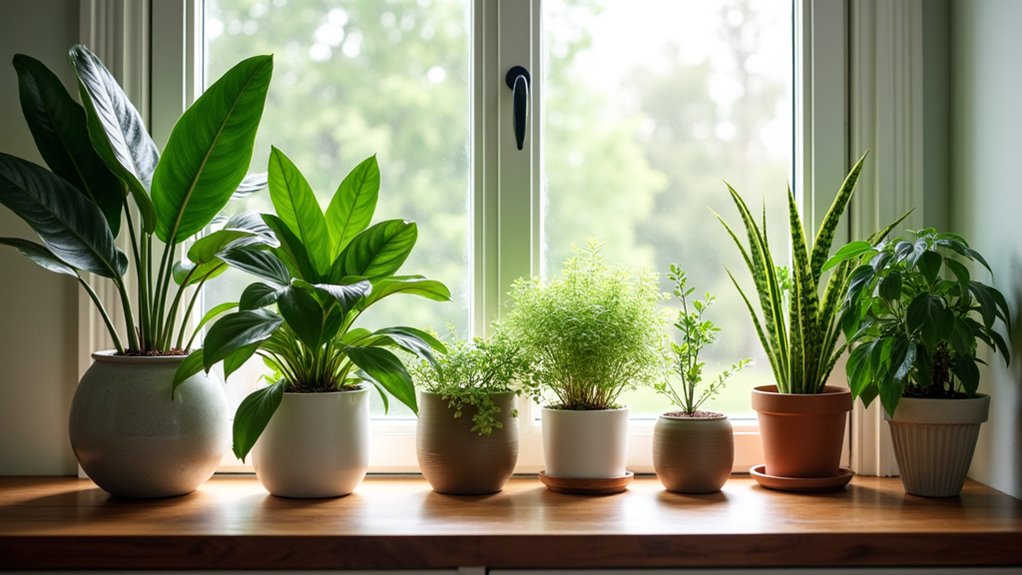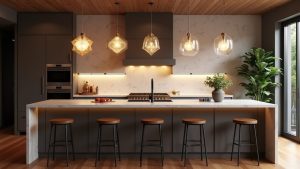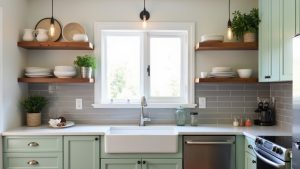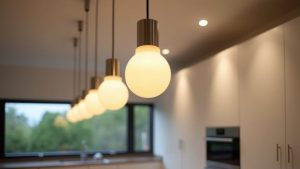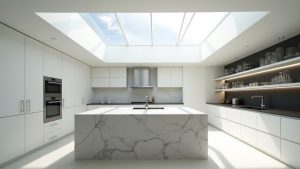For those seeking low-light plants that thrive in kitchen environments, several options stand out. The Snake Plant and ZZ Plant are both drought-tolerant and require minimal care. The Chinese Evergreen boasts stunning foliage, while Pothos adds vibrant colors but requires monitoring. Dracaena varieties and the resilient Aspidistra offer beautiful greenery with low maintenance. Each of these plants enhances indoor air quality and decor. Discover more about their unique benefits and care tips for ideal kitchen greenery.
Key Takeaways
- Snake Plant thrives in low light, requires infrequent watering, and purifies indoor air, making it ideal for kitchens.
- ZZ Plant’s glossy leaves tolerate low light and minimal water, enhancing kitchen aesthetics effortlessly.
- Chinese Evergreen showcases stunning foliage patterns, thrives in low light, and adapts to kitchen humidity with minimal care.
- Pothos is a fast-growing vine that thrives in low light; however, it should be kept away from pets due to toxicity.
- Dracaena varieties and Aspidistra are resilient options for low-light kitchens, requiring minimal care while enhancing indoor air quality.
Snake Plant (Sansevieria)

The Snake Plant, scientifically known as Sansevieria, stands out as an ideal choice for low-light environments, particularly in kitchens. Its remarkable light adaptability allows it to thrive in extremely dim conditions, making it perfect for spaces without abundant natural sunlight. However, for optimal growth, it prefers bright, indirect light, while tolerating the artificial lighting common in many kitchens. This resilient plant exhibits significant humidity tolerance, making it suitable in moisture-rich settings, yet it is also drought-tolerant, requiring infrequent watering. Additionally, despite being classified as a plant that can survive in low light, it can still benefit from some exposure to brighter conditions. The Snake Plant’s air-purifying abilities make it a great option for improving indoor air quality in your kitchen. Slow growth in low light leads to fewer offsets, but its striking upright, sword-shaped leaves add style to any interior. Known for its hardiness, the Snake Plant is a low-maintenance option well-suited for busy lifestyles.
ZZ Plant (Zamioculcas Zamiifolia)

Often compared to the Snake Plant for its tolerance in low-light conditions, the ZZ Plant (Zamioculcas zamiifolia) emerges as another excellent choice for kitchen environments.
With its glossy, thick leaves, the ZZ plant not only enhances indoor aesthetics but also offers several benefits, including improved air quality.
ZZ plant care is straightforward, as it thrives in bright, indirect light while tolerating low-light spaces. This drought-tolerant plant requires minimal watering, allowing the top two inches of soil to dry out completely between sessions.
Ideal temperatures range from 60°F to 85°F, and keeping it away from direct sunlight prevents leaf scorch. Its architectural appearance and low maintenance make it perfect for busy kitchens, contributing to a vibrant, healthy home.
Chinese Evergreen (Aglaonema)

Chinese Evergreen (Aglaonema) stands out as a resilient houseplant that thrives in low-light environments, making it an ideal addition to kitchens that may lack abundant natural light.
Known for its stunning variegated foliage, various Chinese Evergreen varieties display captivating patterns and colors, such as the popular ‘Silver Queen’ with its dark green and silver stripes.
Various Chinese Evergreen varieties, like the ‘Silver Queen,’ boast stunning variegated foliage with captivating dark green and silver patterns.
This plant requires minimal Chinese Evergreen care, thriving in average indoor temperatures and tolerating fluctuations in humidity.
It prefers indirect light but can adapt to artificial lighting, making it versatile for various kitchen settings.
With its low maintenance needs, occasional pruning, and moderate watering, it effortlessly enhances kitchen spaces while requiring little effort from its owner.
Pothos (Epipremnum Aureum)

When seeking a resilient houseplant for a kitchen with limited natural light, Pothos (Epipremnum aureum) emerges as an exceptional choice.
This fast-growing vine adapts well to low light but flourishes with indirect sunlight. Variegation types, such as ‘Golden Pothos’ and ‘Neon,’ bring vibrant colors into any space.
However, Pothos care involves some considerations:
- Monitor light exposure to maintain variegation.
- Prune regularly to prevent leggy growth.
- Be aware of toxicity concerns; ingestion can cause discomfort.
With easy maintenance tips, like tolerating irregular watering, Pothos remains a preferred kitchen plant. Keep it away from pets and children, and ensure proper drainage to avoid root rot.
Its hardiness makes it a beloved choice for plant enthusiasts.
Ivy (Hedera)

Ivy (Hedera) presents a versatile option for kitchens seeking a touch of greenery, especially in spaces with limited sunlight. Renowned for its adaptability, ivy thrives in bright indirect light but can also tolerate low light, albeit with slower growth.
Proper ivy care involves maintaining moist soil while preventing overwatering, which can lead to root rot. Various ivy varieties, including Common Ivy (Hedera helix) and Persian Ivy (Hedera colchica), cater to different soil preferences, such as alkaline and acidic environments.
Additionally, ivy’s self-clinging ability allows it to scale vertical surfaces, making it perfect for maximizing kitchen space. Its evergreen nature ensures year-round vitality, enriching kitchen aesthetics while harmonizing with the humid climate often found in cooking areas.
Dracaena Varieties

Dracaena varieties stand out as excellent choices for kitchen environments, particularly due to their remarkable adaptability to low light conditions. While they thrive in bright, indirect sunlight, many can tolerate low light, making them versatile in home decor.
Dracaena varieties excel in kitchens, thriving in low light and adding versatility to home decor.
Some particularly well-suited types include:
- Dracaena deremensis ‘Janet Craig’: Highly shade-tolerant, perfect for dim spots.
- Dracaena sanderiana (Lucky Bamboo): Grows well in low to medium light.
- Dracaena fragrans ‘Massangeana’ (Corn Plant): Adapts nicely to medium light while maintaining its aesthetic appeal.
Proper Dracaena care includes allowing the soil to dry between waterings and ensuring a well-draining mix.
Additionally, Dracaena propagation can be achieved through cuttings, making it easy to expand one’s indoor plant collection.
Aspidistra (Cast Iron Plant)

Aspidistra, commonly known as the Cast Iron Plant, exemplifies resilience and adaptability in low-light environments, making it a prime choice for kitchen decor.
With its deep green, arching leaves that can grow up to 2–3 feet tall, this evergreen perennial brings natural beauty to shaded spaces.
Aspidistra care is minimal, requiring well-drained soil and moderate watering, allowing it to thrive even with occasional neglect.
This hardy plant benefits indoor air quality by trapping dust and reducing allergens, contributing to a healthier home.
Its versatility allows it to flourish in various locations, from kitchen corners to office desks, while its classic aesthetic complements diverse interior designs, adding a touch of elegance in low-light settings.
